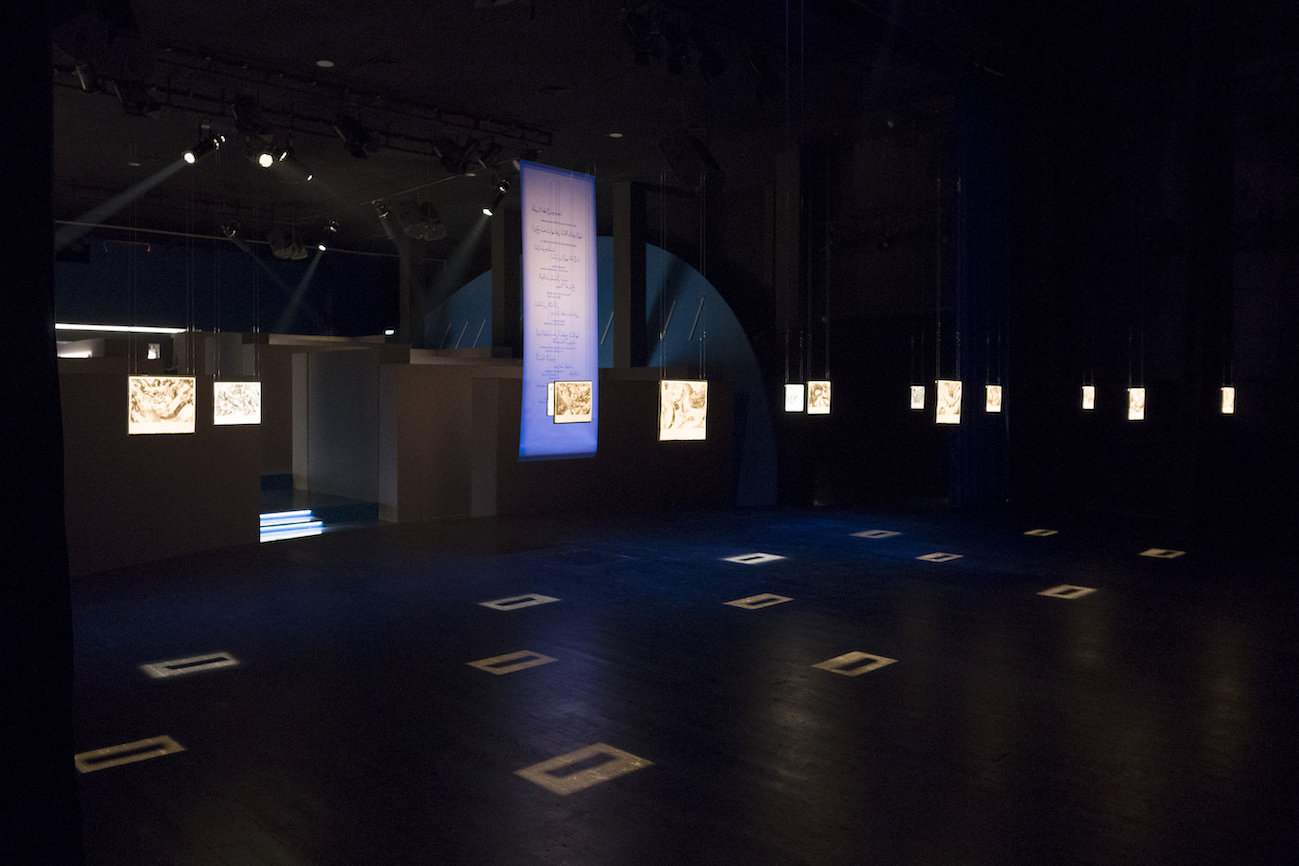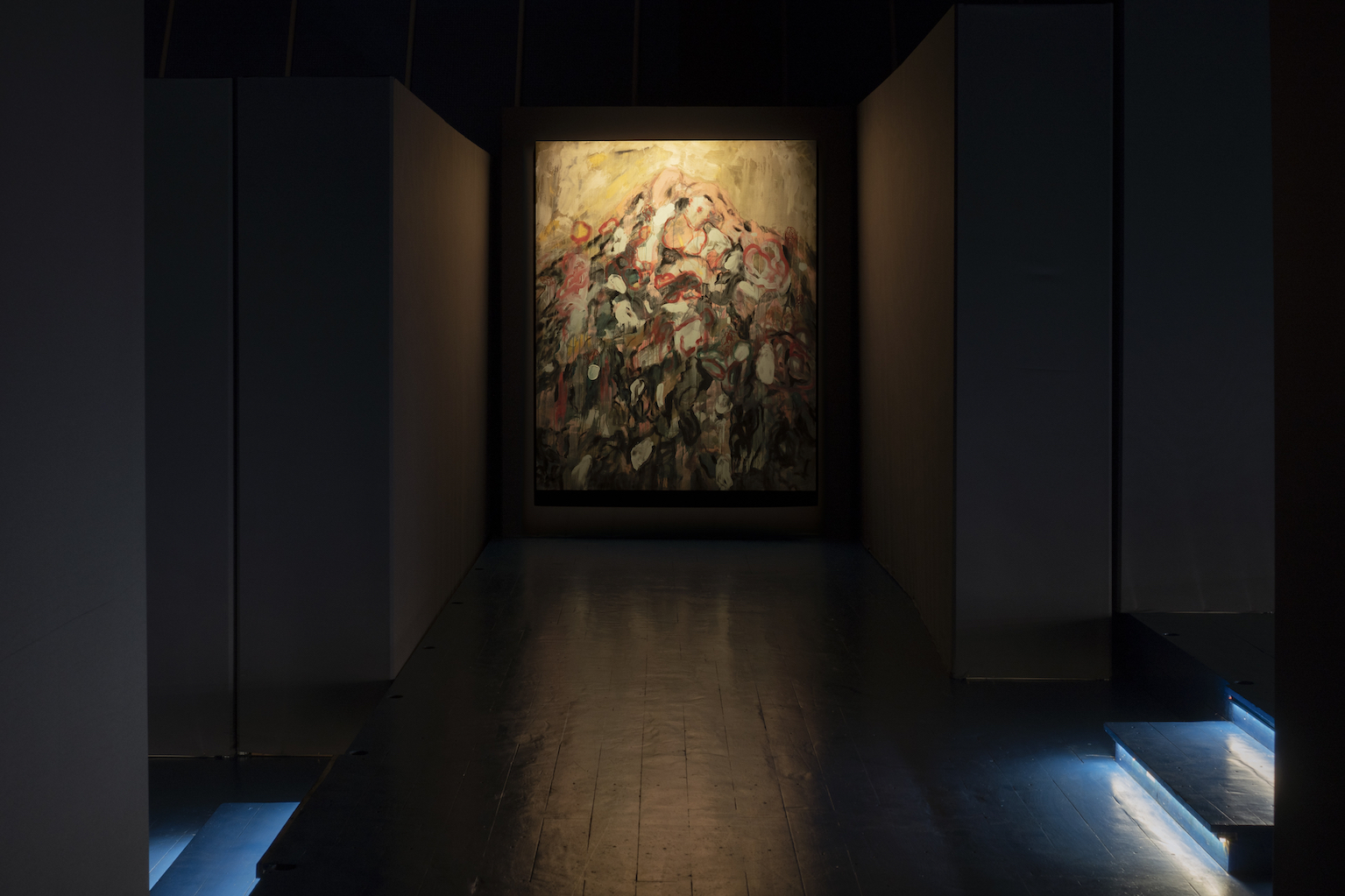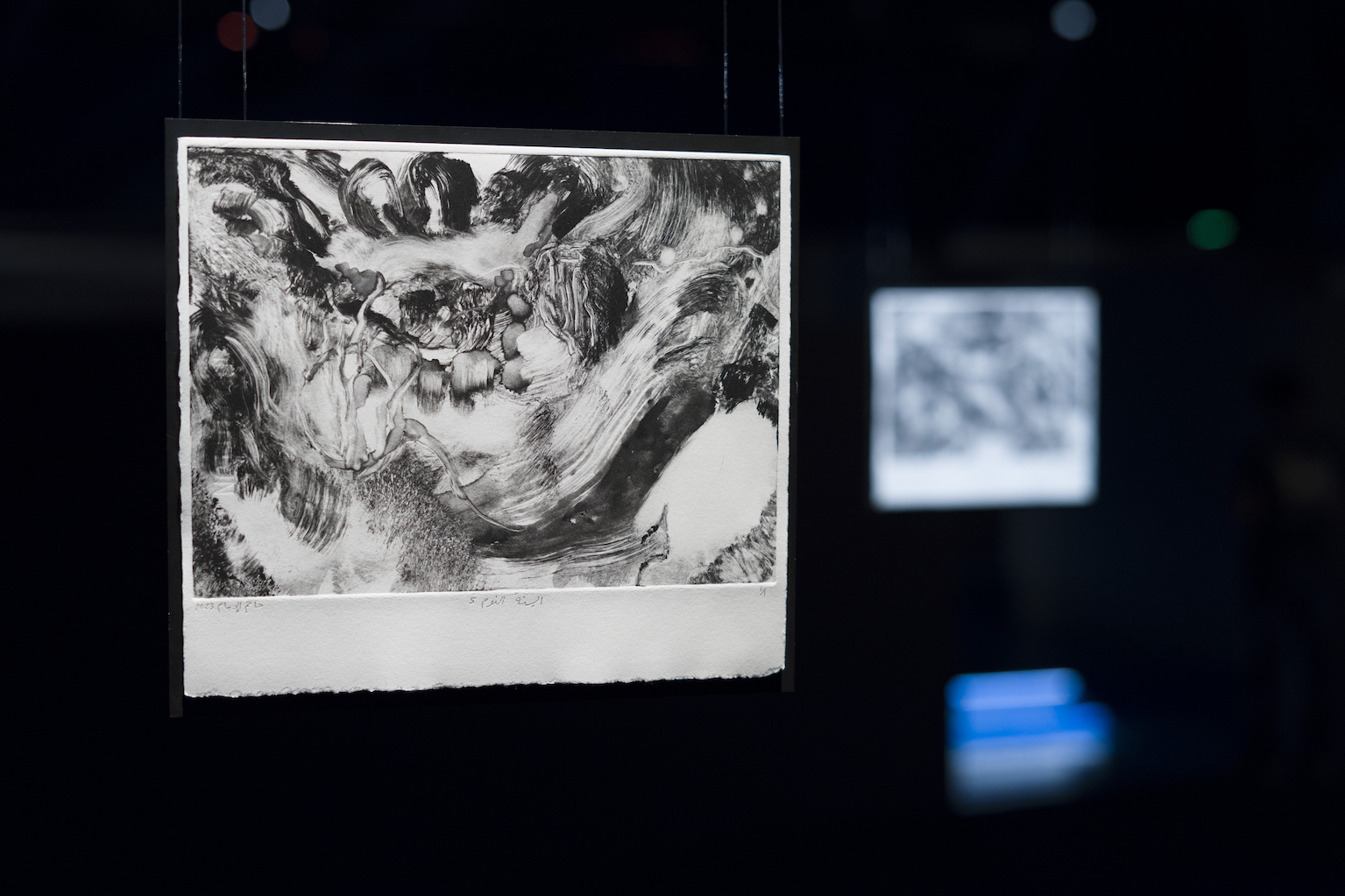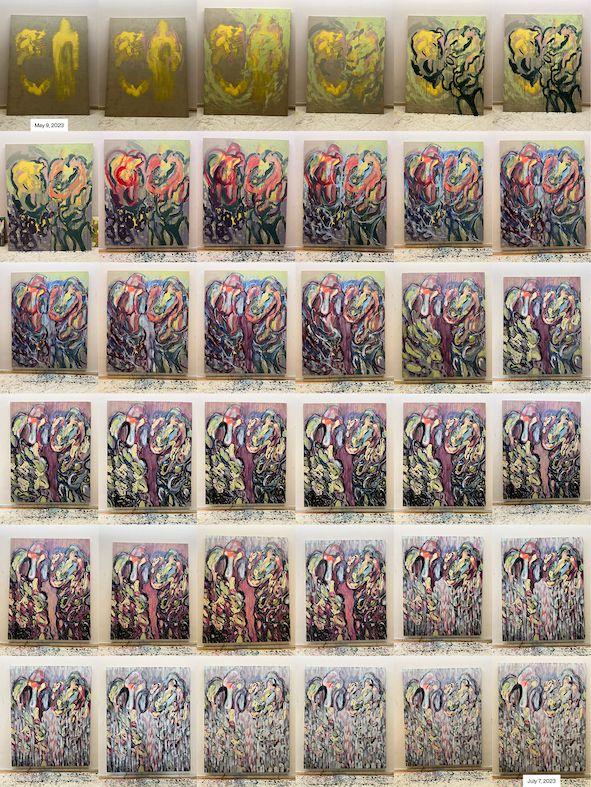Imam’s ‘Scene VIII.’ (Courtesy of the artist).
BEIRUT—The auditorium of Metro al-Madina has been transformed, briefly, into an exhibition hall. On the terraces where the audience is meant to be entertained, an installation has been built that forms 10 narrow passages, each a gallery housing a single mixed-media painting.
Ten of the theater’s spotlights are trained on each of these works, while 14 onstage-spots gaze straight down — illuminating the 13 monotypes (unique ink prints) suspended from the rafters and a bilingual banner that is the show’s sole textual feature. The theater itself is otherwise unlit. Happily there is air con.
There is sound too. A unique electronic drone radiates from speakers secreted adjacent to each canvas. Air molecules throughout the hall vibrate from the humming chorus arising from the installation.
The retooling is in aid of Slumber’s Tongues. This weeklong exhibition features 10 paintings and 13 monotypes that artist and graphic designer Hatem Imam has completed in the past six months.
The canvases (works of various dimensions in oils and acrylics, with occasional charcoal accents) are colorful, multilayered pieces that combine features of landscape and abstraction. Much smaller (25.5 x 23cm) and more concise, the monotypes, from Imam’s Soft Sleep (al-Laynat al-Noum) series, are monochrome works that also evoke landscapes.
 An installation shot from the ‘Soft Sleep’ series, on show in ‘Slumber’s Tongues.’ (Credit: Paul Gorra)
An installation shot from the ‘Soft Sleep’ series, on show in ‘Slumber’s Tongues.’ (Credit: Paul Gorra)
For the artist and his collaborators at Art Design Lebanon, the site-specific audio-visual installation housing his work isn’t some sort of rebellion against the white cube — the unadorned white interior that’s long been the industry standard for art exhibitions.
“I wanted [the viewer’s] first encounter with the painting to be from a distance,” Imam says, to the accompaniment of his choral drone. “Typically, in a white cube, you go toward the painting, then you maintain this median distance as you move laterally from one work to the next. Here, I wanted to [ensure] that your encounter with the painting will already be at a distance, and that you will see only one painting at a time.”
He says he’s interested in what viewers find as they observe his work from varying distances and how “the sound draws you in, or pushes you away.”
The only barrier separating the onstage works is the relative darkness falling between individual monotypes, but their presentation is also equally deliberate — hung with their backs to the audience, as it were, so that viewers must address the work like performers, sliding laterally between spotlights.
This orchestration of the public’s viewing recalls the spatial conceits of Imam’s debut exhibition, Thresholds, curated by Amanda Abi Khalil and staged at Letitia Gallery, just off Hamra Street, in 2018-19.
“You go all the way to the back [of the room], then you turn to face the actual work,” Imam says. “Our position in relation to the work is quite central, I think.”
 An installation shot from ‘Slumber’s Tongues.’ (Credit: Paul Gorra)
An installation shot from ‘Slumber’s Tongues.’ (Credit: Paul Gorra)
Sabbatical work
Imam (b. 1978) is one of Beirut’s multitasking cultural laborers. As a visual artist he’s exhibited individually and with Atfal Ahdath — variously translated as “Juvenile Delinquents” or “Children of Events,” events being a Lebanese euphemism for the country’s spasms of violent strife, civil war and such — his collaboration with Vartan Avakian and Raed Yassin. The trio’s delinquency is dormant these days, as all three are constantly juggling multiple projects in various parts of the world. For his part, Imam is also the co-founder of the design agency Studio Safar (he took a six-month sabbatical from there to work on this show), the design and visual culture magazine Journal Safar, Samandal comics and Annihaya records. He also teaches design and printmaking and is a resident DJ at Radio Alhara.
During his recent return to the studio, Imam experimented further with the practice he was exploring before the events of late 2019, and continuities and departures are evident. Fictive abstract landscape is the subject of the work in both his Beirut exhibitions, but Thresholds was a show of monochromes — monotypes on paper and zinc plates (the medium engraved and painted to make monotypes). In Slumber’s Tongues, the principal works’ medium, color palate and goals are somewhat different.
“Landscape is always my starting point,” he says. “What’s different in this show is that there are shapes that could be read as figures. [Depending on your perspective,] looking at a distance or up close, you might see full figures or parts of bodies emerge from what otherwise might have seemed a landscape.”
While line-drawn motifs are occasionally woven into some of these landscapes, Imam isn’t making highbrow versions of a “Where’s Wally?” puzzle (“Where’s Waldo?” for North American readers). For the most part, the figuration that members of the public find in his abstractions is perceived, not deliberately rendered.
“This is completely process-based practice,”he says. “I didn’t start this work thinking that this is where I wanted to go. I started discovering this on the way, somehow ... Every painting has many different layers. I’ll start working on a painting, and it could reach a certain place. Then I will leave it and start on another one. Then I’ll return to this.”
He gestures to a canvas that some might imagine has a photo of a Mesopotamian clay artifact superimposed upon it. “I left this one for a very long time, then a week or two before the opening, I returned to it. All of these washes and reds are the last things that I added. In many cases the layers may be translucent, you see through them, but sometimes they completely cover what was happening behind. What you see is just a result of layers of different brushstrokes.”
The line drawings in various pigments are among the mixed-media elements in the new work.
“This is charcoal,” he confirms, nodding at a vaguely figural form peering from behind swirls and splotches of color. “This is new for me, mixing charcoal with oils. I’m interested in this thin line between giving viewers some impression of perspective or space and then breaking it up, so I find the contrast between the very broad brushstrokes and the very thin lines useful.”
 An installation shot from ‘Slumber’s Tongues,’ showing monotype ‘Soft Sleep 5.’ (Credit: Paul Gorra)
An installation shot from ‘Slumber’s Tongues,’ showing monotype ‘Soft Sleep 5.’ (Credit: Paul Gorra)
Imam doesn’t consider the exhibition’s sonic accompaniment to be augmenting his paintings and prints.
“It’s something that’s running in parallel with the painting,” he says. “Of course, you can look at the painting without the sound, but within this particular installation, I felt that there’s something more performative at work. It also has to do with the dramatic lighting, the scenography, the stage …
“I’ve been experimenting with sound in relation to paintings or drawings for a while. In a way landscape art is our negotiating our relationship with land, visually … and vision has its own parameters. [With an image,] it’s as if your eye automatically understands that there’s an inside and an outside, but there is no inside and outside with sound. It just permeates space.”
A Beirut power cut falls, plunging the room into silent gloom.
“If we’re talking about what the landscape looks like,” Imam continues sotto voce, “how does it sound?”
Some invisible hand closes a circuit, reanimating the chorus of drones.
“I’m excited about the possible tension between the sound and the painting … I don’t see the painting as a sacred object. For a lot of people, the painting needs to stand on its own, but painting can have different uses in different contexts.”
 A series showing the evolution of Imam’s canvas titled ‘Scene VIII,’ May-July 2023. (Courtesy of the artist)
A series showing the evolution of Imam’s canvas titled ‘Scene VIII,’ May-July 2023. (Courtesy of the artist)
Some of the most powerful work on show are prints. On stage, Imam explains how the monoprints of the Soft Sleep series were instrumental to his experiments with painting.
“I wasn’t planning to make any monotypes,” he recalls. “I was so excited about having my own big studio where I can do larger works, and I was completely engulfed in the colors and the oil paint and all that.
“Then, this motherfucker over here …” He nods to the terrace installation, referring to one of his larger paintings in the show — a landscape in pale green, pink, blue and yellow, perhaps with charcoal highlights, whose melted composition may seem oddly evocative of the late work of Syrian-born German artist Marwan.
“It’s probably the piece that I worked on the most, because it gave me such a hard time. At times I was ready to throw it away and just be done with it. Annie [Vartivarian, founder of Art Design Lebanon] was suggesting that I make some prints for the show, so one day I decided to do some monotypes.
“It opened up something completely new,” he smiles. “The process of making this series is quite different than usual for me. Typically, for a monotype, I would cover the plate in black, then work by subtraction. This is the first series in which I do the reverse, applying ink to a blank plate, which is closer to painting.
“I went back to the painting with fresh eyes because,” he pauses, “because it’s so stripped down. It’s monochrome. It’s small. You cannot work in layers, one layer only, so your tools, your vocabulary is much more limited. This limitation is what pushes you.”
Slumber’s Tongues has been extended until Sunday, July 23. The show’s closing party will go ahead tonight, Thursday, July 20, at Metro al-Madina, featuring a live set with synthesist June As. The show starts at 8.30 p.m. Entrance is free of charge.
